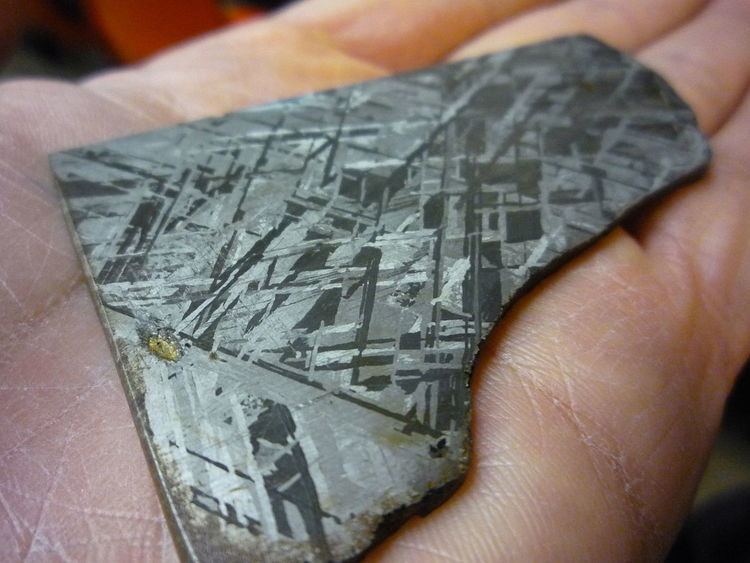Luster Metallic | Space group Different structures Diaphaneity Opaque | |
 | ||
Formula(repeating unit) Fe and Ni in different ratios | ||
Meteoric iron, sometimes meteoritic iron, is a native metal found in meteorites and made from the elements iron and nickel mainly in the form of the mineral phases kamacite and taenite. Meteoric iron makes up the bulk of iron meteorites but is also found in other meteorites. Apart from minor amounts of telluric iron, meteoric iron is the only naturally occurring native metal of the element iron on the Earth's surface.
Contents
Mineralogy
The bulk of meteoric iron consists of taenite and kamacite. Taenite is a face centered cubic and kamacite a body centered cubic iron-nickel-alloy.
Meteoric iron can be distinguished from telluric iron by its microstructure and perhaps by its chemical composition also, since meteoritic iron contains more nickel and less carbon.
Trace amounts of gallium and germanium in meteoric iron can be used to distinguish different meteorite types. The meteoric iron in stony iron meteorites is identical to the "gallium-germanium group" of the iron meteorites.
Structures
Meteoric iron forms a few different structures that can be seen by etching or in thin sections of meteorites. The Widmanstätten pattern forms when meteoric iron cools and kamacite is exsolved from taenite in the form of lamellas. Plessite is a more fine-grained intergrowth of the two minerals in between the lamella of the Widmanstätten pattern. Neumann lines are fine lines running through kamacite crystals that form through impact-related deformation.
Cultural and historical usage
Before the advent of iron smelting, meteoric iron was the only source of iron metal apart from minor amounts of telluric iron. Meteoric iron was already used before the beginning of the iron age to make cultural objects, tools and weapons.
In ancient Egypt an iron metal pearl was found in a graveyard near Gerzeh that contained 7.5% Ni. A dagger made from meteoric iron was found in the tomb of Tutankhamun. This dagger consists of similar proportions of metals (iron, nickel and cobalt) to a meteorite discovered in the area, deposited by an ancient meteor shower.
The Inuit used parts of the Cape York meteorite.
Fragments from Gibeon were used for centuries by the Nama people. There are also reports of their use for manufacture of various items in Tibet (see Thokcha), including the Iron Man, a statue of Vaiśravaṇa carved from an iron meteorite. In 1000 CE, a Tibetan Buddhist statue, the Iron Man, was likely carved from an ataxite meteorite. It might even be made from a fragment of the Chinga meteorite.
Even after the invention of smelting, meteoric iron was sometimes used where this technology was not available or metal was scarce. A piece of the Cranbourne meteorite was made into a horseshoe around 1854.
Today meteoritic iron is used in niche jewellery and knife production, but most of it is used for research, educational or collecting purposes.
Atmospheric phenomena
Meteoric iron also has an effect on the Earth's atmosphere. When meteorites descend through the atmosphere outer parts are ablated. Meteoric ablation is the source of many elements in the upper atmosphere. When meteoric iron is ablated it forms a free iron atom, that can react with ozone (O3) to form FeO. This FeO may be the source of the orange bands in the spectrum of the upper atmosphere.
